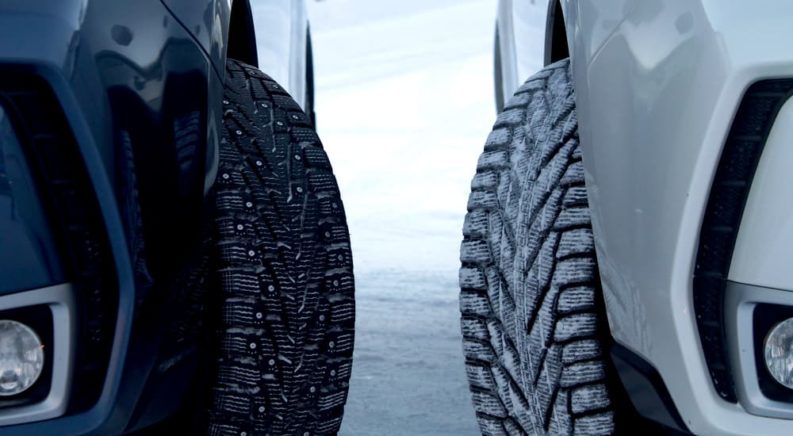If you weren’t already aware, tires are not a one tire fits all situations thing; there are different tires for various purposes. If you live in a colder climate or a place that enjoys snow during the winter season, then you need to switch out your normal tires to winter tires when the temperature drops. If you’re searching for “winter tires near me,” you probably have some questions about how winter tires work and how to change them. While the process is quite simple, there are a few things you should know before you dive into buying winter tires and putting them on your car.
What Are Winter Tires?
You may have heard of all-season tires and be under the impression that these will suffice for year-round usage. However, if you live in a climate that experiences cold, snowy winters, all-season tires just won’t cut it. You need to look into getting winter tires. All-season tires are great for the early fall and late spring, but they simply don’t provide the same level of traction in snow or ice as winter tires do.
When you live in an area that experiences snow, ice, or slush, winter tires are highly recommended for the colder months of the year. This is the case even if you have all-season tires installed on your vehicle. Unlike all-season tires, winter tires are designed with specialized rubber that will not deteriorate or lose traction in freezing temperatures. Partnered with a unique deep tread pattern to help the grip, winter tires are far superior to all-season tires when the snow begins to fall.
What is so dangerous about driving on ice, snow, or slush? The answer is slippage. This occurs when there isn’t enough traction (or grip) between the tire and the road. Losing control of your vehicle on a slick road can leave you stranded in a ditch for hours, smashed against a tree or a guard rail, or even turn into a potentially deadly accident when there are other people or vehicles around. The key to avoiding a catastrophe is to have the appropriate gear equipped on your vehicle. This means winter tires.
Winter tires are designed with specialty biting edges, channels, and grooves that grab onto the ice/snow/slush and dig into it for optimal grip. This causes the water to be pushed away from the contact surface of the tire. The result is much better traction and control while driving in poor road conditions.
Available in a wide range of sizes and shapes, winter tires are designed to fit all kinds of vehicles. You can find models for sedans, SUVs, trucks, and even high-performance vehicles. The cost of a winter tire set will vary depending on which size you need. Larger wheels tend to cost more than smaller ones.
Pro Tip: Never mix-and-match tires. You always want to have a set of four winter tires equipped at the same time. Do not try to cut corners by just buying winter tires for two tires if you have front-wheel or rear-wheel drive.

Top 5 Benefits of Winter Tires
#1 – Winter tires offer increased grip on slick roads to reduce the risk of hydroplaning.
#2 – Increased grip makes it easier to stop and start when on a hill.
#3 – Winter tires provide the maximum stopping power in slippery conditions.
#4 – Flexible rubber will allow you to drive safer over icy roads, deep snow, and in freezing temperatures.
#5 – Winter tires provide you with a sense of security.
No matter what type of weather is going on outside, the world keeps turning. Even if the schools are canceled or your place of work is closed for a snow day, you may need to head to the grocery store for provisions. With a set of winter tires, this task will be much more manageable and much less dangerous.
When Should I Change to Winter Tires?
The answer to this question may vary depending on where you live, the type of weather that commonly occurs in your area, and when the weather typically changes. A good rule of thumb to follow is to change to winter tires when the average temperature is around 45°F. Even if it doesn’t snow at all for a season, it’s better to have winter tires on dry roads than it is to drive on summer tires during a freak snowstorm. Plus, even if it doesn’t snow, cold temperatures still bring the potential for black ice, and winter tires can help prevent you from sliding on slick roads.
Pro Tip: If your area is consistent with its winter weather every year, then it won’t hurt to put a full set of winter tires on a separate set of alloy or steel wheels. If you do this, you won’t have to take the time to go to a mechanic every year to change out your tires. You can simply swap them out yourself with a quick bolting session.
How Can I Change to Winter Tires?
At this point, you may be wondering how you can change your summer tires to winter tires on your own. I recommend having your winter tires professionally mounted to a dedicated set of inexpensive steel or alloy wheels. Doing this will allow you to change out your tires by yourself. If you know how to change a flat tire, then swapping out summer tires for winter tires should be easy enough.
There are a few things you will need before you can get started. Make sure that you have a service jack, a breaker bar, safety stands, a compressor, and either a lug wrench or sockets. During storage, tires tend to lose air pressure. This is what the compressor is for. Check the air pressure before you install the winter set, and inspect the tires for leaks.
Your car should be turned off with the parking brake set in order to change out the tires. Make sure you are in a safe and secure area, then you can start swapping. Loosen the nuts of your current wheels and remove them. Loosen the tires a little while they are still on the ground so the resistance will help keep the wheel from moving, and the tires will be easier to remove once you lift the car up. Take care not to strip the sockets while you do this.
Next, once everything is loose, you’ll want to lift the wheel off the ground, fully remove the nuts, and pull the wheel off. Once the wheel is removed, you can mark the tire’s position with a tire crayon on the inside of the sidewall so you can keep track of what tires came from where. Next, take a moment to inspect the brakes and spray on a lubricant to prevent corrosion. Now it’s time to put your winter set on.
Lift up your new wheels and line them up with the lug bolts. When you get the winter tire into position, you should begin tightening the nuts by hand. Then, lower your vehicle back to the ground to finish tightening them, as the resistance from the ground will help make sure you get them tight. Finish tightening them with either a hand tool or an air tool, depending on what you have. We recommend using a torque wrench to ensure your bolts are tightened to the correct value (outlined in your owner’s manual). Keep in mind that the nuts should be tightened in a cross-sequence.

When Should I Change Back to Summer Tires?
When the average temperatures start to rise up to 50°F and higher, it is usually safe to switch back to summer tires. However, this may vary depending on your area. Some regions are prone to surprise snowstorms late in the season. A good rule of thumb to follow is to look at the flowers. When the plants begin to bloom, that’s a good indicator that spring is upon us. You can go ahead and switch your tires back out.
Find Winter Tires Near Me
Winter tires are a great way that you can take on driving in the winter. Just remember to change your winter tires back to summer or all-season tires when the weather warms up because winter tires will deteriorate faster in the heat. When you’re done with your winter tires, be sure to store them in airtight bags in a dry location out of direct sunlight to help preserve the rubber.
There are many different tire brands that manufacture good winter tires, and you can find them just about anywhere that sells tires. If you aren’t comfortable changing your tires yourself, then take them to your local mechanic, service center, or tire shop to have them put on. There are plenty of places that offer tire service, so while you can easily change out your tires yourself, you don’t have to.

